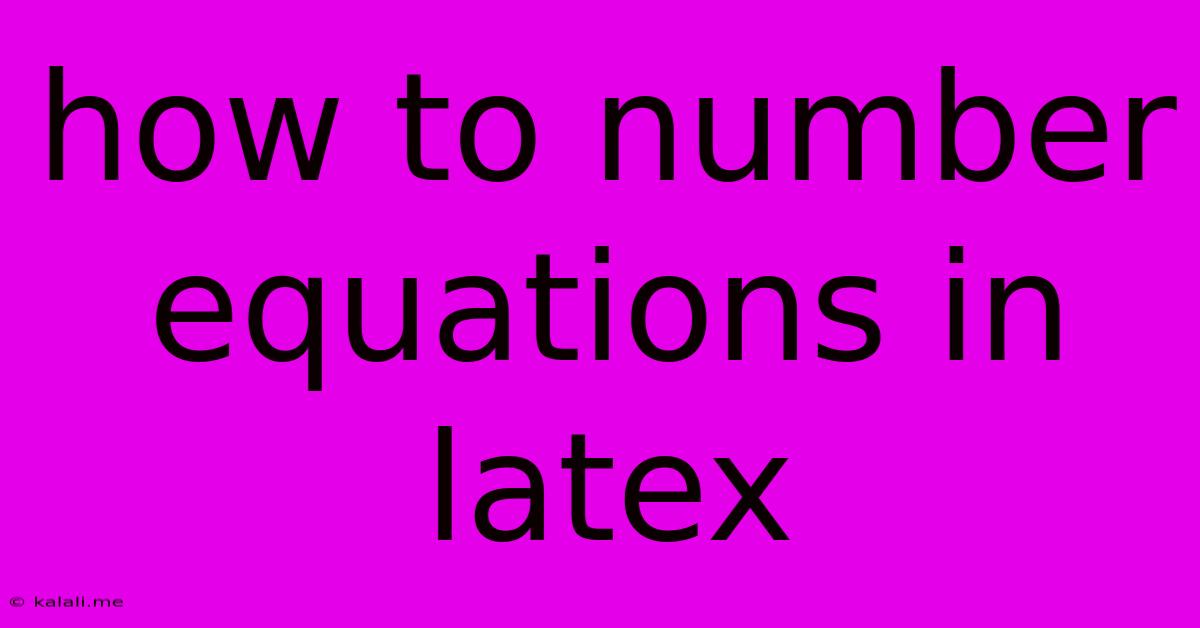How To Number Equations In Latex
Kalali
May 25, 2025 · 3 min read

Table of Contents
How to Number Equations in LaTeX: A Comprehensive Guide
This article provides a comprehensive guide on how to number equations in LaTeX, covering various scenarios and advanced techniques. Understanding equation numbering is crucial for creating well-structured and professional-looking scientific documents. We'll cover the basics, different numbering styles, and how to manage equation references effectively.
Basic Equation Numbering
The simplest way to number an equation in LaTeX is to enclose it within the equation environment:
\begin{equation}
E = mc^2
\end{equation}
This will automatically generate a numbered equation, typically on the right-hand side. LaTeX will handle the sequential numbering for you.
This approach is suitable for standalone equations. However, for more complex scenarios, using the equation environment might not be the most efficient or flexible method.
Using the align Environment for Multiple Equations
When working with multiple equations, particularly those spanning several lines or requiring alignment, the align environment is preferred:
\begin{align}
a + b &= c \\
x^2 + y^2 &= r^2
\end{align}
This will number each equation separately, providing a clean and organized presentation, especially beneficial for derivations or showing step-by-step calculations. The & symbol specifies the alignment point.
Controlling Equation Numbering: equation* and align*
Sometimes, you might not want an equation to be numbered. In such cases, simply add an asterisk (*) after the environment name:
\begin{equation*}
This equation will not be numbered.
\end{equation*}
\begin{align*}
These equations will also remain unnumbered. \\
Another unnumbered equation.
\end{align*}
This is useful for intermediate steps, definitions, or equations that are not part of the main numbered sequence.
Referencing Equations: \eqref
Referencing equations within your text is straightforward using the \eqref command:
The famous mass-energy equivalence is given by equation \eqref{eq:einstein}.
\begin{equation} \label{eq:einstein}
E = mc^2
\end{equation}
The \label command assigns a unique label to the equation, which \eqref then uses for referencing. This is crucial for maintaining consistency and readability, especially in longer documents.
Customizing Equation Numbering Styles
For more advanced control over numbering, you can use packages such as amsmath and mathtools. These packages provide options for customizing the numbering style, for instance, using section-specific numbering or altering the numbering format.
Numbering Equations Within Subsections
To number equations according to their subsection, you might need to employ the amsmath package and utilize its features to redefine equation numbering. The specifics depend on the chosen document class but often involve using counters. Consult the amsmath documentation for specific instructions.
Troubleshooting and Common Mistakes
- Missing
\begin{equation}or\end{equation}: Ensure that every equation is properly enclosed within the appropriate environment. - Incorrect
\labelusage: Make sure\labelis placed inside the equation environment and the label name is unique. - Package Conflicts: If you encounter unexpected behavior, ensure there are no conflicts between different packages you're using.
By mastering these techniques, you'll be well-equipped to create professional-looking LaTeX documents with neatly numbered and referenced equations, enhancing the readability and overall quality of your scientific writing. Remember to always consult the comprehensive documentation for LaTeX and relevant packages for the most accurate and up-to-date information.
Latest Posts
Latest Posts
-
How Much Is 25 20 Dollar Bills
Jul 05, 2025
-
How Many Apples In 3 Lb Bag
Jul 05, 2025
-
What Is Half A Quarter Of 400
Jul 05, 2025
-
How Do You Make A Vegetable Necklace
Jul 05, 2025
-
How Many 750ml Are In 1 75 Liters
Jul 05, 2025
Related Post
Thank you for visiting our website which covers about How To Number Equations In Latex . We hope the information provided has been useful to you. Feel free to contact us if you have any questions or need further assistance. See you next time and don't miss to bookmark.